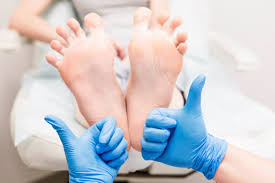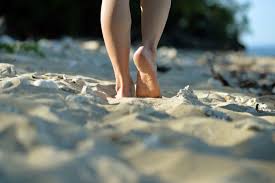
Diabetes Foot Care: A Step-by-Step Guide
Welcome to our comprehensive guide on foot care, specifically tailored for individuals grappling with diabetes and circulatory conditions. In this resource, we delve into essential tips, exercises, and massage techniques to ensure optimal foot health. Understanding the significance of proactive care is crucial for preventing complications and maintaining overall well-being. Let’s step together towards healthier feet.

For individuals living with diabetes or circulatory conditions, foot care is not just a matter of comfort; it is crucial for maintaining overall health and preventing potentially severe complications. Poor circulation and nerve damage are common complications associated with these conditions, making the feet vulnerable to infections and injuries.
Proper foot care is crucial for individuals with diabetes and circulatory conditions. Due to reduced blood circulation and impaired nerve function, these individuals are more susceptible to foot problems that can lead to serious complications. However, with proactive care and attention, it is possible to maintain healthy feet and reduce the risk of complications.
Why Foot Care Matters:
The feet serve as the foundation of our mobility, and they bear the brunt of our weight and daily activities. However, in individuals with diabetes and circulatory conditions, compromised blood flow and reduced sensation can lead to significant foot problems such as slow healing of wounds and an increased risk of infections. Here’s why foot care is of paramount importance:
-
Prevention of infections: Reduced blood flow impairs the body’s ability to fight infections. Even minor foot injuries, like cuts, blisters, or ingrown toenails, can develop into serious infections such as foot ulcers and gangrene that are slow to heal and may result in amputation.
-
Preservation of sensation: Nerve damage (neuropathy) is common in diabetics and individuals with circulatory conditions. Loss of sensation in the feet increases the risk of unnoticed injuries or wounds, as the person may not feel pain or discomfort.
-
Maintenance of mobility: Foot issues can severely limit mobility and independence. Taking proactive measures to care for the feet can help prevent complications that might hinder walking and physical activities.
-
Wound Healing: Poor circulation can impede the healing process, making foot injuries or wounds more difficult to heal. Caring for your feet reduces the risk of wounds and promotes faster healing.
-
Nerve Health: Nerve damage, known as neuropathy, is common in individuals with diabetes. Regular foot care can help identify any loss of sensation or abnormal sensations, enabling prompt medical intervention.
-
Amputation Prevention: Unattended foot problems, infections, or ulcers can escalate to a point where amputation may become necessary. Diligent foot care significantly reduces the risk of amputations.
How To Examine Your Feet for Abnormalities: Regular foot examinations are crucial for detecting potential problems. Here’s how to examine your feet: 
- Check for any swelling in the feet, ankles, or legs.
- Monitor for any changes in skin color.
- Examine Nail and Toenail Beds: Look for ingrown toenails, infections, or changes in color. Check for any abnormalities such as discoloration, thickening, or ingrown nails
- Use a mirror if needed to examine the soles and other hard-to-reach areas. Examine the soles for calluses, corns, or ulcers.
- Pay attention to any changes in sensation, such as numbness or tingling.
- Inspect the Skin: Check for any redness, blisters, calluses, cuts, or sores.
- Assess Sensation: Use your hands to lightly touch different areas of your feet and assess any loss of sensation.
- Monitor Temperature: Compare the temperature of your feet to the rest of your body. Monitor for warmth. Cool or cold feet may indicate circulation problems.
If you notice any concerning changes or have difficulty examining your feet, consult a healthcare professional promptly.
Recognizing Signs of Foot Problems:

If you notice any of the following signs, it is important to seek medical attention promptly:
- Open sores, wounds, ulcers, blisters, or cuts that do not heal or are slow to heal
- Ingrown toenails or fungal infections.
- Pain, burning, or cramping in the legs or feet.
- Changes in skin color or temperature.
- Persistent pain, tingling or swelling in your feet or ankles
- Redness, warmth, or tenderness that does not subside
- Corns, calluses, or warts
- Foul odor or discharge from a wound or infection
- Numbness, tingling, or loss of sensation in the feet
- Swelling or redness that does not subside.
- Changes in foot shape or arch structure.
How to Care for Your Feet:
- Wash your feet daily: Use mild soap and lukewarm water to clean your feet, gently drying them afterward. Avoid soaking your feet, as it can dry out the skin. Be sure to dry them thoroughly, especially between the toes.
- Keep skin moisturized: Apply a diabetic-friendly moisturizer to prevent dryness and cracking but avoid applying it between the toes to prevent excess moisture buildup.
- Trim toenails carefully:
 Cut your nails straight across and file the edges to prevent ingrown nails. Avoid cutting too close to your skin to prevent damage to same. If you have difficulty trimming them yourself, seek professional assistance.
Cut your nails straight across and file the edges to prevent ingrown nails. Avoid cutting too close to your skin to prevent damage to same. If you have difficulty trimming them yourself, seek professional assistance. - Wear proper footwear: Choose shoes that fit well, provide adequate support and cushioning. Ensure that the shoes have a wide toe box to avoid pressure on the toes. Opt for seamless socks and avoid high heels, shoes with pointed toes, tight shoes, or sandals that leave your feet exposed. Inspect your shoes regularly for any foreign objects or rough edges that could cause injury.
- Protect your feet: Wear comfortable and well-fitting shoes and avoid walking barefoot, even at home to protect your feet from injuries. Use protective footwear and breathable shoes when necessary and check your shoes for foreign objects before wearing them. Choose seamless socks made of natural fibers to prevent irritation and improve circulation.
- Perform daily foot inspection: Examine your feet thoroughly on a daily basis, looking for any cuts, blisters, redness, swelling, or signs of infection. Use a mirror or seek assistance if necessary to examine the entire foot, including the soles and between the toes.
- Practicing proper foot hygiene: Wash your feet daily with warm water and mild soap, ensuring that you dry them thoroughly, especially between the toes. Moisturize your feet to prevent dryness but avoid applying lotion between the toes to prevent excessive moisture buildup.

- Protection: Always wear clean, dry socks that fit well, preferably made of breathable materials like cotton or moisture-wicking fabrics. Use protective footwear, such as diabetic shoes or custom orthotic inserts, to reduce pressure points and minimize the risk of injuries.
- Regular check-ups: Visit a podiatrist or foot specialist regularly for comprehensive foot examinations, especially if you have pre-existing foot conditions or are experiencing any foot problems.
Exercises and Massage for Foot Health:

Exercise: Engaging in regular physical activity helps improve circulation and overall foot health. Low-impact exercises like walking, swimming, and cycling are excellent choices. Consult your healthcare provider before starting any exercise program.
- Gentle stretching exercises: Rotate your ankles, flex and point your toes, and stretch the calf muscles to improve circulation and flexibility.
- Toe and foot exercises: Pick up marbles with your toes, scrunch up a towel using your toes, or use an exercise band for resistance exercises to strengthen foot muscles.
- Regular walking: Engaging in regular walking helps improve blood flow and overall foot health.
- Toe stretches: Spread toes apart and hold for a few seconds, then relax. Gently stretch your toes upward and downward to maintain flexibility. Repeat several times.
- Ankle rotations: Rotate the ankles clockwise and counterclockwise for a few minutes.

- Toe raises: While seated, lift toes off the ground, hold for a few seconds, and then lower them. Repeat 10-15 times.
- Ankle pumps: Flex and extend your feet at the ankles several times, improving blood flow.
- Foot rolls: Roll a tennis ball or a frozen water bottle under your feet to massage and stimulate circulation.
- Calf raises: Rise up onto your toes and then lower yourself, working your calf muscles and enhancing blood flow. This exercise should not be performed by persons with blood clots or pain, swelling, warmth and tenderness to the calf. Be sure to seek advice from a licensed physician before doing this exercise.
Foot massage: Massage can enhance circulation, relieve tension, and promote relaxation. Gently massage your feet using lotion or oil, paying attention to the soles, arches, and toes. Alternatively, consider seeking professional foot massage therapy. Use gentle circular motions and a moisturizer to massage your feet, promoting blood flow and relaxation. Avoid massaging areas with wounds or blisters.

Foot care is of utmost importance for individuals with diabetes and circulatory conditions. By practicing daily foot care routines, examining the feet regularly for abnormalities, recognizing signs of foot problems, and incorporating exercise and massage techniques, you can maintain optimal foot health and reduce the risk of complications. Remember, early detection and timely medical intervention you can significantly reduce the risk of serious foot complications.
Disclaimer: The information provided in this content is for general informational purposes only. It is not intended as medical or healthcare advice, diagnosis, or treatment. Always seek the advice of a qualified healthcare professional with any questions you may have regarding a medical condition or healthcare decisions.


 Cut your nails straight across and file the edges to prevent ingrown nails. Avoid cutting too close to your skin to prevent damage to same. If you have difficulty trimming them yourself, seek professional assistance.
Cut your nails straight across and file the edges to prevent ingrown nails. Avoid cutting too close to your skin to prevent damage to same. If you have difficulty trimming them yourself, seek professional assistance.















